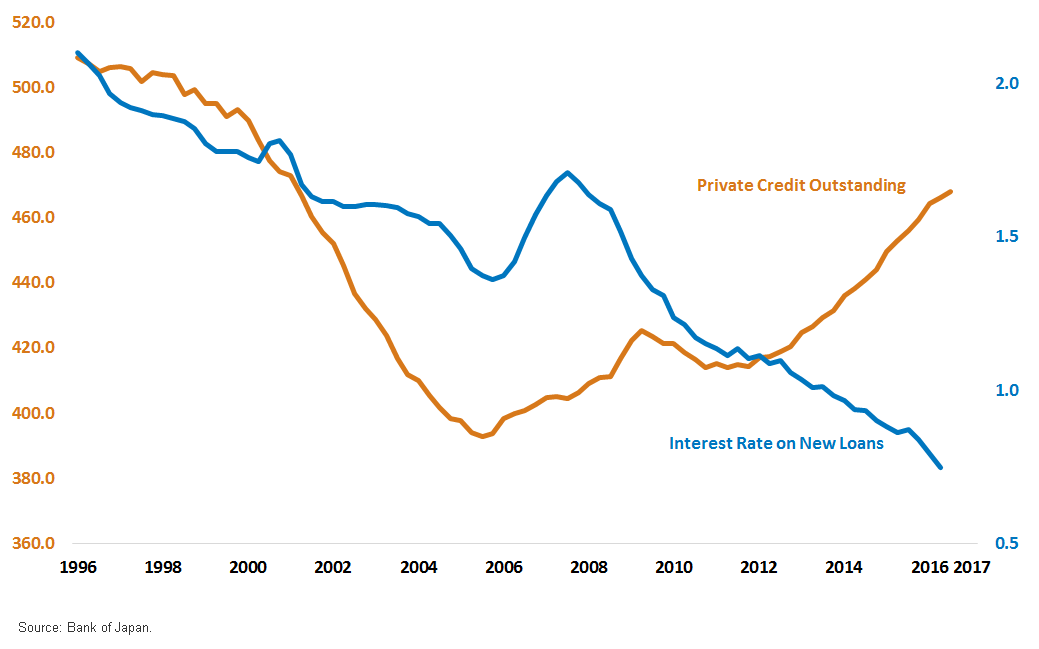Yes, BOJ Policy Is Working—Credit Cycle Up and Zero for Long


Yes, Private Sector Credit Is Up and Sustainable
In our view, the growing evidence of a sustainable private sector releverage cycle is a key reason why we do not expect additional monetary easing from Japan. Moreover, the recent change in BOJ focus away from “quantity of credit” targets and toward “price of credit” targets—capping 10-year Japanese government bond (JGB) yields at zero—is consistent with the empirical evidence that the Japanese monetary policy transition mechanism is working again, i.e., lower interest rates actually raise the quantity of private credit.
The data on interest rates and private sector credit is telling. The chart below plots the total yen amount of private sector credit outstanding versus the average interest rate charged on new loans. Between 1995 and 2005, Japan was stuck in a massive deleveraging cycle. Private sector credit dropped by more than 20% of gross domestic product (GDP), completely irresponsive to the relentless decline in the cost of credit. A brief period of modest releveraging was abruptly halted by the global financial crisis, which pulled Japan back into a liquidity trap (where quantity of credit is inelastic to the price of credit).
What matters is that Japan’s “balance sheet recession” ended in early 2013. Since then, private credit has expended steadily, up by almost 15% of GDP between early 2013 and September 2016. Most importantly, the relationship between the price of credit and the quantity reverted to “normal”—lower interest rates generate higher quantity of private credit.
Japan Is Finally Back in a “Normal” Credit Cycle
For BOJ policy, this “normalization” of Japan’s private sector credit function—banks are strong enough to supply more credit despite lower margins, and the private sector is demanding more credit as costs drop—is very important, in our view. It means that the financial system is functioning well, that both supply and demand factors are now “inflating” the economy.
The most important consequence of all this is that the role of the central bank can begin to normalize as well—during the deleveraging cycle, the BOJ focused on “quantity” of its own balance sheet growth to underwrite the need of private banks for a “buyer of last resort” for their assets. Now that a private sector releveraging cycle has started (and been sustained for almost three years), a “quantity” target is no longer necessary. Targeting the price of credit should once again be sufficient to control the quantity.
To be sure, the BOJ has opted for an extremely cautious approach of normalization. After all, the “price” it is targeting for the 10-year bond—which serves as the benchmark for the cost of new loans—is a zero nominal yield. This translates to an effective average new loan rate of around 72–75 basis points (bps). In other words, the nominal cost hurdle rate for debt finance is minuscule. For example, Tokyo real estate still offers cap rates of around 3%, i.e., more than 200 basis points of positive carry. And Japanese equities offer a dividend yield of 2% (TOPIX as of October 28, 2016), i.e., a more than 100-basis point positive spread.
So the BOJ is taking no chances and is treading extremely lightly. However, the shift away from a “quantity of credit” target to a “price of credit” target is entirely logical and, in our view, very welcome.
“Zero for Long”—Can the Credit Cycle Accelerate?
From here, we expect a relatively long period of BOJ inaction. Barring an external shock—such as a U.S. recession and/or a U.S. dollar collapse, or a yuan devaluation—the next move will come when it becomes clear that private bank credit growth continues despite the fact that interest rates are no longer falling. Step one was to reassert that falling rates sustain a private sector credit growth cycle. Step two will be continuing credit growth even though the rate cycle has bottomed. Clearing this hurdle should take at least nine to twelve months. The BOJ is “zero for long,” in our view.
This “zero for long” cycle could only be brought forward if Prime Minister Abe’s structural reforms accelerate—and trigger a more aggressive business investment up-cycle. We’ll learn more about this in the coming months as Japan’s budget and structural reform agenda move to the frontline again in preparation of next year’s budget.
Private Credit Outstanding and Interest Rate on New Loans

Important Risks Related to this Article
Investments focused in Japan increase the impact of events and developments associated with the region, which can adversely affect performance.

